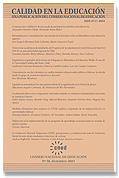Equity in Maths: Mechanisms Underlying the Sharpening of the Gender Gap
DOI:
https://doi.org/10.31619/caledu.n59.1392Keywords:
Maths Gender Stereotypes, Early Childhood Education, Gender BeliefsAbstract
Given that early maths skills are crucial predictors of later academic success, the results from the latest maths SIMCE (System for Measurement of Quality in Education) are cause for alarm. These results reveal a concerning setback in gender equality in mathematical learning, particularly affecting girls from low socioeconomic status (SES) backgrounds. Neuroscience indicates that both men and women share a similar biological basis for mathematical learning. Hence, the observed gender gap may be attributed to social beliefs associating mathematics more with masculinity than femininity. In Chile, studies have demonstrated that these beliefs are prevalent among teachers, families, and children as young as 5 years old, even more so than in other countries. It is also evident that these beliefs vary based on gender and SES. To design effective early interventions, it is crucial to understand the nature of these beliefs through genuine listening and active participation of children in research studies.
Downloads
Published
Issue
Section
License
Authors retain their Copyright and only transfer a part of these to the journal, accepting the following conditions:
Authors keep their rights as authors and guarantee the right to the journal for the first publication of their work, which is simultaneously subject to the Creative Commons Attribution license allowing third parties to share the study accrediting the author and first publication in this journal.
Authors may adopt other non-exclusive license agreements for distribution of the version of the published work (e.g. inclusion in an institutional thematic file or publication in a monographic volume) accrediting initial publication in this journal.
Authors are allowed and recommended to share their work over the Internet (e.g. in institutional telematic files or their website) before and during the submission process, which may lead to interesting exchanges and increased citation of the published work. (See The effect of open access).

